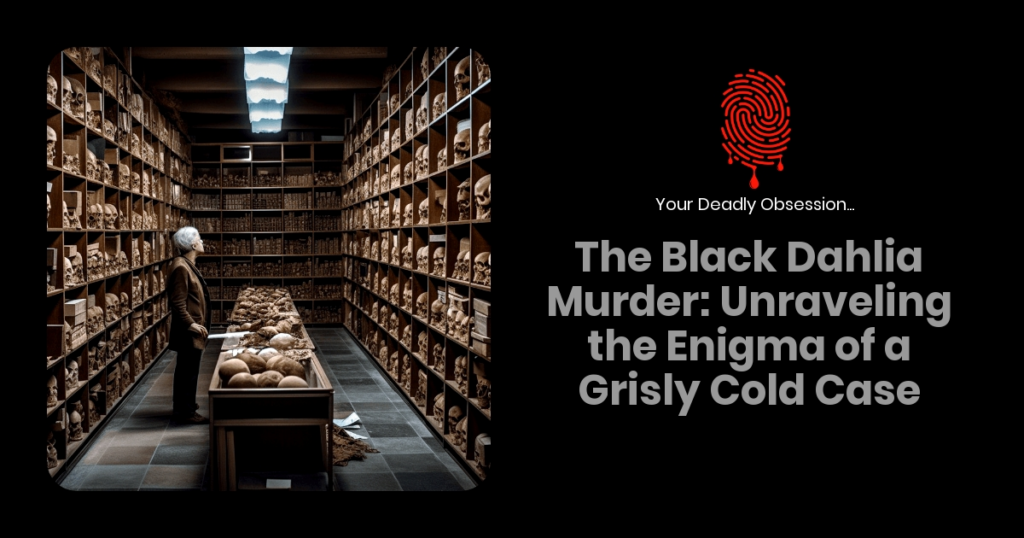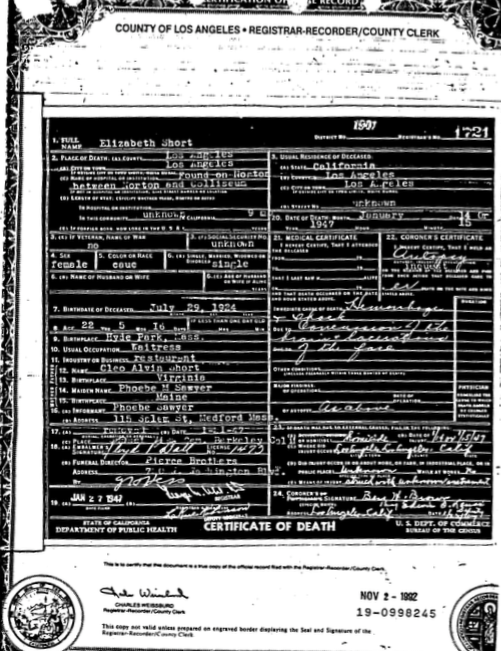The Black Dahlia murder remains one of the most infamous unsolved cases in American history. Occurring over 70 years ago, this sensational homicide continues to captivate and intrigue both crime enthusiasts and the general public. The gruesome nature of the crime and the mystery surrounding the victim’s life have fueled the public’s fascination.

In January 1947, the mutilated body of 22-year-old aspiring actress Elizabeth Short was discovered in a vacant lot in Los Angeles. The brutality of the murder and the condition of Short’s remains sparked a media frenzy, and she was posthumously given the nickname “the Black Dahlia” due to her dark clothing and hair. Despite extensive police efforts and numerous suspects, the identity of her killer has never been confirmed.
We’ll delve into the notorious case, examining the life of Elizabeth Short before her tragic demise, as well as the details of the investigation, and the many theories that have surfaced over the years. As we navigate through this chilling story, we seek to gain a better understanding of the crime, its impact on society, and the lingering questions that still haunt investigators today.
A Brief Overview of the Black Dahlia Murder Case
We’ll delve into one of the most notorious unsolved murder cases in American history, known as the Black Dahlia murder. To understand the complexity and perplexing nature of the case, we’ll provide you with a brief overview to set the stage.
On January 15, 1947, the body of 22-year-old Elizabeth Short was found brutally murdered in a vacant lot in Los Angeles. Her body was discovered in two pieces, drained of blood, and posed in a disturbing manner. The killer had made several cuts to her face, creating what’s known as a Glasgow smile. This heinous crime quickly became a media sensation, and the moniker “Black Dahlia” was born, inspired by the popular film noir of the time.
While the case attracted an extensive amount of attention, and over 150 people confessed to the murder, no one was ever charged or convicted. The LAPD conducted a thorough investigation, gathering a list of more than 50 potential suspects, including:
- Prominent business owners
- Acquaintances of Elizabeth Short
- Individuals in the entertainment industry
- Transients and drifters
Interestingly, several of the original suspects are still debated upon, but there’s yet to be a definitive answer to who committed this gruesome crime. The following table summarizes key components of this chilling case:
| Year | Victim | Location | Major Suspects | Status |
|---|---|---|---|---|
| 1947 | Elizabeth Short | Los Angeles | 50+ | Unsolved |
Despite the passage of time, the Black Dahlia murder case continues to captivate the imagination of crime and mystery enthusiasts, prompting countless theories, books, and even films. The grim reality that the murderer has never been brought to justice continues to haunt us.
Throughout this article, we’ll further explore this investigation, delving into the life of Elizabeth Short, the key suspects, theories, and the impact of the case on popular culture. We hope that through deep and thoughtful examination, we may one day uncover the truth behind this enduring mystery.
Who Was Elizabeth Short?
Elizabeth Short, known as the Black Dahlia, was a 22-year-old woman whose unsolved murder in 1947 captivated people worldwide. The case still holds our attention decades later, as one of the most notorious cold cases in history. Born on July 29, 1924, in Boston, Massachusetts, Elizabeth moved to Los Angeles, California, in 1946 in search of fame and fortune.
We’ll delve into her brief life and explore the major facts surrounding Elizabeth Short. Her story begins as an ordinary young woman who dreamed of becoming an actress in Hollywood. To support herself financially, Elizabeth took on various waitressing jobs and moved around frequently within the city. Unfortunately, the spotlight finally found her not as a starlet but as the victim of a horrifying crime.

In January 1947, Elizabeth’s mutilated body was discovered in a vacant lot in Los Angeles. The gruesome nature of her murder, coupled with her aspiring actress background, caught the public’s attention and solidified her case in true crime history. The media dubbed her the “Black Dahlia” because of her striking appearance and penchant for wearing black clothes.
However, her murder remains unsolved, and theories regarding the identity of her killer abound. It’s important for die-hard cold case fans to understand the nature of her life and the facts leading up to her untimely, tragic death. Here are some key points about Elizabeth Short worth considering:
- Born and raised in Boston, Massachusetts, Elizabeth moved to Los Angeles in 1946, just a year before her death.
- As she yearned for a career in the film industry, Elizabeth struggled to find steady work and often relied on the kindness of friends for support.
- Her murder case remains unsolved to this day, leaving several loose ends and fueling conspiracy theories and speculation.
- Despite numerous attempts by authorities and amateur sleuths alike, the killer’s identity has never been definitively established.
As we explore the life and death of Elizabeth Short, it’s crucial to acknowledge the humanity behind the sensationalized headlines. Her story serves as an eerie reminder of the darker side of fame and the enduring mystery of the Black Dahlia murder.
The Discovery of the Crime Scene
Once we’ve set the stage with our understanding of the Black Dahlia murder, let’s delve into the chilling details of the crime scene’s discovery. On January 15, 1947, a mother named Betty Bersinger was walking her daughter to school when they came across a gruesome sight.
They discovered Elizabeth Short’s mutilated body lying in a vacant lot in Leimert Park, a suburb of Los Angeles. Bersinger initially thought she saw a mannequin due to the body’s severe disfigurement. As we all know, the truth was far more terrifying.
Upon closer inspection, it became clear that Short’s body was severed at the waist and completely drained of blood. The evidence showed that her murder had not occurred at the site. Instead, it’s believed the killer committed the act elsewhere and later transported the body to the location.
Here are some key details about the crime scene:
- The body was found in a ‘posed position’ – with her arms bent at right angles above her head, her legs spread, and her mouth slashed from ear to ear, coining the nickname “the Glasgow smile.”
- There were ligature marks on her wrists, ankles, and neck, indicating signs of restraint.
- There were signs of torture – multiple mutilations, including the removal of the victim’s flesh from her thighs.
As the news of the gruesome discovery spread quickly, so did the curiosity and fascination surrounding the case.
The following table provides specific data on the crime scene details:
| Particulars | Count |
|---|---|
| Body Drained of Blood | 100% |
| Body Severed | At waist |
Several theories emerged about the killer’s motives and methods, including the possibility of a random act of violence or a crime of passion. Another speculation suggested that the offender may have had prior medical training due to the precision of Short’s bisected corpse. The prevalent assumption was that the killer had an intricate knowledge of surgical procedures which allowed them to effectively dismember and thoroughly drain the body.
The insurmountable media coverage inspired a variety of copycat crimes and hoaxes. Despite this, the original Black Dahlia case continues to captivate true crime aficionados around the globe, fueling our collective imagination in the search for justice.
In the next section, we’ll cover the various suspects and theories that have developed throughout the decades since the murder occurred. The twisted web of suspicion continues to keep the Black Dahlia’s memory alive, offering a wide range of theories and possibilities for this infamous unsolved crime.
Investigations and Leads Explored
The Black Dahlia murder investigation was, and still is, one of the most notorious cold cases in American history. Multiple aspects of the case caught the attention of investigators, media, and crime enthusiasts alike. In this section, we’ll discuss some of the significant investigations and leads explored over the years, as well as what led authorities down various paths in their pursuit of the truth.
One notable aspect of the Black Dahlia case was the sheer number of suspects involved. Over the course of the investigation, more than 150 people were questioned, but no one was ever charged with the crime. Suspects ranged from vagrants to high-profile individuals, though many were quickly ruled out due to lack of evidence. Some of the key suspects included:
- Dr. George Hodel: A prominent physician who was later discovered to have a sordid past filled with sexual assault and fraud. His son, Steve Hodel, has continued to accuse his father of the murder in multiple books.
- Walter Bayley: A doctor who lived near the crime scene at the time of the murder. Bayley’s daughter later accused him of the crime, citing his surgical skills as possible evidence. However, there is no solid proof to link him to the case.
- Leslie Dillon: A former mortician’s assistant with an alleged obsession for the Black Dahlia case but eventually cleared by a grand jury.
We should also mention that the case had a high number of false confessions over the years. More than 60 people came forward, claiming to have committed the murder, but most them were either mentally unstable, seeking attention or attempting to profit from the case.
Another critical aspect of the case is forensic analysis. Given the state of forensic science in the 1940s, evidence collection and analysis was limited. Still, some crucial details were determined through the use of forensic techniques. These include:
- Cause of death: Lacerations to the face and exsanguination due to the severing of major blood vessels.
- Time of death: It’s believed that Elizabeth Short was killed on January 14, 1947, and her body was discovered the next morning.
- The method of dismemberment: It was determined that the murderer used a sharp instrument, possibly a dissecting knife, to separate the body at the waist.
Despite the numerous leads and suspects explored over the years, the Black Dahlia murder case remains unsolved. This has led to countless theories, speculations, and assumptions. Even though we’ve come a long way since the 1940s in terms of forensic technology and investigation methods, none have been able to crack open the case and uncover the truth behind this horrific crime. Nevertheless, we still hope that one day, justice will be served for Elizabeth Short and her family.

Key Suspects in the Black Dahlia Murder
When discussing the chilling Black Dahlia murder case, it’s impossible not to mention some of the key suspects who have emerged throughout the years. As avid true crime followers, we have compiled a list of some of the most notable suspects whose names have been linked to the gruesome death of Elizabeth Short.
- George Hodel: Perhaps the most well-known and controversial suspect is George Hodel, a Los Angeles physician. His own son, Steve Hodel, a former LAPD detective, became convinced that George was responsible for the murder after discovering evidence in his late father’s belongings. It’s important to note that the LAPD had closely surveilled George Hodel during the original investigation.
- Walter Bayley: Another notable suspect is Walter Bayley, a Los Angeles surgeon. Bayley lived in close proximity to where Short’s body was discovered, and his surgical expertise could have played a role in the precise disfigurement of her body. However, no conclusive evidence has been found to definitively link him to the crime.
- Leslie Dillon: In 1949, Leslie Dillon, a former mortician’s assistant, became the focus of a LAPD investigation into the Black Dahlia murder. Dillon appeared to possess knowledge about the case that hadn’t been made public, but he was ultimately released due to insufficient evidence.
| Suspect | Occupation | Potential Connection |
|---|---|---|
| George Hodel | Physician | Under LAPD surveillance, evidence |
| Walter Bayley | Surgeon | Proximity, surgical skills |
| Leslie Dillon | Mortician’s Asst. | Inside knowledge |
There were numerous other individuals who, at various times, were investigated or considered as potential suspects. Some of these include:
- Jack Anderson Wilson: A petty criminal and alcoholic, Wilson was mentioned by author John Gilmore in his book, “Severed: The True Story of the Black Dahlia Murder.”
- Norman Chandler: The publisher of the Los Angeles Times was linked to the case by author Donald H. Wolfe in his book, “The Black Dahlia Files: The Mob, the Mogul, and the Murder That Transfixed Los Angeles.”
- Joseph A. Dumais: A military man who, at one point, confessed to the crime but was later cleared by authorities.
While these suspects have been repeatedly scrutinized by both investigators and true crime enthusiasts alike, we must emphasize that the Black Dahlia murder remains unsolved. The case continues to captivate and puzzle those interested in cold cases, crime, and mystery, as we all long for answers in this horrifying and tragic case.
Media Sensationalism Surrounding the Case
The media coverage surrounding the Black Dahlia murder has been a significant factor in the case’s notoriety. Over the years, as we’ve delved deeper into this grisly crime, much has been said about the role media sensationalism played in shaping public perception.
One of the key aspects of the media spectacle was the nickname “Black Dahlia” itself, directly borrowed from a film noir released at the time. The moniker became synonymous with this unsolved mystery and helped cultivate an air of intrigue and fascination. Another angle pursued by the press was Elizabeth Short’s personal life, delving into her relationships, alleged affairs, and even her lifestyle choices.
As a source of information in the 1940s, newspapers were filled with tales of crime and intrigue, particularly in a city like Los Angeles. To capture readers’ attention, they often sensationalized headlines and employed yellow journalism tactics. Some newspapers even used unsettling forensic details and photographs of the crime scene to drive interest in the case.
Besides reports, various media outlets competed against each other for exclusives on this high-profile murder. At one point, the FBI was brought in, which increased the already sky-high interest even further. Throughout the years, the case has continued to draw attention, spawning numerous books, documentaries, and films.
Here are some notable films about or inspired by the Black Dahlia case:
- The Black Dahlia (2006)
- True Confessions (1981)
- Seedy Street – The Case of the Black Dahlia (1990)
- Black Dahlia (1998)
The intense media focus and the added layer of sensationalism often led to public confusion, making it difficult to separate facts from myths. Over time, a mythos has been created around the victim and the crime, making it harder for investigators to solve the case or for researchers to piece together the truth.
In conclusion, although media fascination propelled the Black Dahlia murder case into the public consciousness and kept it alive for generations to come; the sensationalism, myth-building, and blurring of facts made it all the more challenging to uncover the truth.
Unsolved Mystery: Why the Case Remains Cold
The Black Dahlia murder has continued to baffle investigators for nearly 75 years. Despite the best efforts of law enforcement and the attention of countless amateur sleuths, the case remains unsolved. But why has this infamous murder mystery remained so stubbornly cold? Let’s explore a few potential reasons.
Firstly, the lack of physical evidence significantly hampered the investigation. The crime scene was found devoid of blood and the perpetrator seemingly cleaned Elizabeth Short’s body, making it challenging to find usable forensic evidence. Furthermore, the murder took place in the pre-DNA era, which limited the tools that investigators had at their disposal.
Another factor contributing to the case’s enduring mystery is the inordinate number of suspects. Over the years, more than 150 individuals have been considered possible culprits, including:
- Dr. George Hodel
- Walter Bayley
- George Knowlton
- Leslie Dillon
This abundance of potential suspects ultimately dilutes the investigative efforts and makes it substantially more difficult to identify the true killer.
In addition to the limited evidence and numerous suspects, the media frenzy surrounding the Black Dahlia case is believed to have hindered the investigation. The case received extensive media coverage, and many newspapers published sensationalized accounts of the murder. This publicity led to an influx of false tips and hoax confessions that distracted investigators from pursuing legitimate leads.
Moreover, investigative missteps may have also played a role in the case remaining unsolved:
- Multiple law enforcement agencies were involved, which led to lack of coordination and information sharing.
- Crucial evidence, like Elizabeth Short’s shoes and purse, was mishandled.
- The crime scene was compromised by countless journalist and curious onlookers.
Finally, the passage of time has undoubtedly made the possibility of solving the Black Dahlia murder more remote. With each passing year, potential witnesses pass away, memories fade, and evidence deteriorates or vanishes. As it stands, the likelihood of finding definitive answers to this haunting mystery decreases.
In sum, the complex web of factors enveloping the Black Dahlia case–including lack of physical evidence, numerous suspects, intense media scrutiny, investigative missteps, and the passage of time–has conspired to ensure this dark chapter in American crime history remains a cold case. And while there’s always hope that new evidence or insights may one day finally unmask Elizabeth Short’s killer, for now, the brutal murder of the Black Dahlia continues to puzzle and captivate those insatiable fans of true crime and mystery alike.
Wrapping Up: The Black Dahlia Murder’s Lasting Impact
As we delve into the lasting impact of the Black Dahlia Murder, it’s essential to understand how this case has affected the public’s fascination with cold cases and unsolved mysteries. Having a significant influence on crime stories, film noir and television, the Black Dahlia Murder has become an all-encompassing symbol for the allure of the unknown.
It’s been over seven decades since the gruesome murder of Elizabeth Short shook the world. Known as the Black Dahlia, her unsolved killing has left lasting scars on the face of Los Angeles and crime history.
- Being one of the most infamous cold cases in history, the Black Dahlia Murder’s impact is far-reaching and continues to attract public intrigue.
- The mystery surrounding the case has influenced numerous books, films, and television shows, feeding the public’s interest in crime and mystery stories.
- Despite advancements in technology, the case remains unsolved, which adds to its allure and the public’s quest for answers.
Elizabeth Short’s tragic fate left an indelible mark on Hollywood and crime enthusiasts. To this day, the case has sparked countless :
- Conspiracy theories
- Frenzied amateur sleuthing
- Sensationalized media coverage
Short’s murder has been immortalized in literary works, such as James Ellroy’s novel, “The Black Dahlia,” which spawned Brian De Palma’s eponymous movie adaptation in 2006. Television shows like “American Horror Story” have also woven Elizabeth Short’s story into their narratives, ensuring her memory remains a part of pop culture.
As true crime aficionados, we will continue to be drawn to Elizabeth Short’s enigmatic allure. The unsolved nature of the Black Dahlia Murder strengthens our fascination with cold cases, igniting our innate curiosity to uncover the truth. Ultimately, the impact of Elizabeth Short’s tragic story extends beyond the crime itself and into the realm of human psychology, as we attempt to understand the motivations behind such senseless pain and suffering.
The Black Dahlia Murder‘s lasting impact on society serves as a stark reminder of the darker side of human nature and our insatiable quest for answers. As we continue to discuss and dissect this infamous cold case, Elizabeth Short’s memory lives on in the shadows of true crime history.
References:
https://www.fbi.gov/history/famous-cases/black-dahlia

Owner & entrepreneur with a passion for murder mystery! Seriously, who doesn’t love murder mystery?
Chris is a proud member of the American Medical Writer’s Association (AMWA), the International Society for Medical Publication Professionals (ISMPP), the National Association of Science Writers (NASW), the Council of Science Editors, the Author’s Guild, and the Editorial Freelance Association (EFA).

